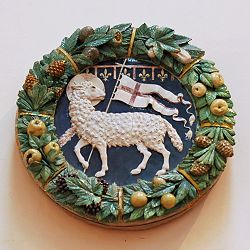
Arte della Lana
Encyclopedia

Guilds of Florence
The guilds of Florence were secular corporations that controlled the arts and trades in Florence from the twelfth into the sixteenth century. These Arti included seven major guilds , five middle guilds and nine minor guilds...
during the Late Middle Ages
Middle Ages
The Middle Ages is a periodization of European history from the 5th century to the 15th century. The Middle Ages follows the fall of the Western Roman Empire in 476 and precedes the Early Modern Era. It is the middle period of a three-period division of Western history: Classic, Medieval and Modern...
and in the Renaissance
Renaissance
The Renaissance was a cultural movement that spanned roughly the 14th to the 17th century, beginning in Italy in the Late Middle Ages and later spreading to the rest of Europe. The term is also used more loosely to refer to the historical era, but since the changes of the Renaissance were not...
. It was one of the seven greater Arti ("trades") of Florence, separate from the Arti Minori (the "lesser trades"). The Arte della Lana dealt in woollen cloth and cooperated with the other corporations of bankers and merchants in administering the commune
Medieval commune
Medieval communes in the European Middle Ages had sworn allegiances of mutual defense among the citizens of a town or city. They took many forms, and varied widely in organization and makeup. Communes are first recorded in the late 11th and early 12th centuries, thereafter becoming a widespread...
, both under the podestà
Podestà
Podestà is the name given to certain high officials in many Italian cities, since the later Middle Ages, mainly as Chief magistrate of a city state , but also as a local administrator, the representative of the Emperor.The term derives from the Latin word potestas, meaning power...
and the Republic of Florence. At the height of the industry the Arte della Lana directly employed 300 workers and indirectly about a third of Florence's population, and produced 100,000 lengths of cloth annually. The Arte della Lana saw all the processes from the raw baled wool through the final cloth, woven at numerous looms scattered in domiciles throughout the city. Like other guilds, the Arte served only to coordinate the activities of its own members, who did not generally own the means of production or directly manage the processes. Its syndics ensured that quality standards were met and contracts were honored.
The predecessor and until the mid-14th century the rival of the Arte della Lana was the powerful Arte di Calimala
Arte di Calimala
The Arte di Calimala, the guild of the cloth finishers and merchants in foreign cloth, was one of the greater guilds of Florence, the Arti Maggiori, who arrogated to themselves the civic power of the Republic of Florence during the Late Middle Ages...
, a corporation of importers of raw cloth, who dyed and finished it.
The guildhall, the Palazzo dell' Arte della Lana, was completed in 1308, with an attached fortifiable tower-house. From its interior, where some 14th-century frescoes remain, a gallery designed by Bernardo Buontalenti
Bernardo Buontalenti
Bernardo Buontalenti, byname of Bernardo Delle Girandole was an Italian stage designer, architect, theatrical designer, military engineer and artist.-Biography:Buontalenti was born in Florence....
links the palazzo with the church of Orsanmichele
Orsanmichele
Orsanmichele is a church in the Italian city of Florence...
. The palazzo is presently the seat of the Società Dantesca.
Further reading
- Gualchiere, 2001.L'arte della lana a Firenze, (Florence: Edifir)
- H. Hoshino, 1980. L'arte della lana in Firenze nel Basso Medioevo: il commercio della lana e il mercato dei panni fiorentini nei secoli XIII-XV, (Florence: Leo S. Olschki)

